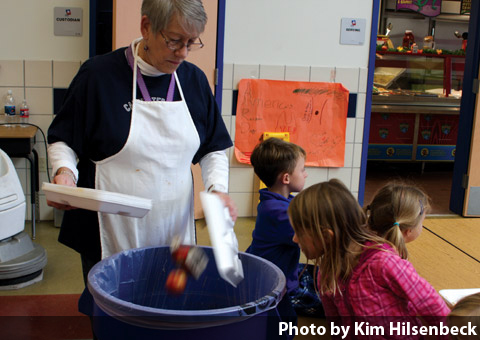by KIM HILSENBECK
Recycling, composting, rainwater harvesting – these are not just buzzwords for Hays CISD. In fact, Rod Walls, the district’s director of new construction and sustainability, says it’s the norm for how school campuses are now built in Hays CISD.
Walls, along with Director of Facilities R.C. Herrin, is making Hays CISD campuses more environmentally friendly. Green building design, digital heating and air-conditioning, rainwater collection systems, single-stream recycling and sensor lighting are just some of the tactics they use.
“We look at everything to see where we can minimize the environmental impact,” Walls said. He said the “green” initiatives also support the district’s five-year strategic plan.
Such greening initiatives are expensive, Walls said, especially at the outset. Carpenter Hill Elementary, which opened in 2010, had a price tag of $13.8 million.
Is it worth it, especially for a school district carrying more than $500 million in debt?
According to Walls, yes.
“Spending more up front saves millions down the road,” he said. “The cost savings and reduced impact on the environment keep going long after the construction is complete.”
Take water: An inch of rainfall on a school’s roof generates 27,600 gallons of water. At schools like Pfluger Elementary School, the gauges show the tanks are full.
Many Hays CISD schools also collect food and other items for composting. Carpenter Hill piloted the program in 2010. “The students got on board quickly, as did the facilities and maintenance staff,” Walls said.
However, Walls said the district now has to purchase more expensive compostable bags made of polylactic acid for the lunchrooms. Those 33-gallon bags cost 32 cents each compared to regular garbage bags that cost 24 cents. Each school uses about seven compostable bags a day.
Still, Walls said the district reduced landfill waste by 70 percent because of its recycling and composting efforts.
Herrin said he has not seen any downside to the district’s green efforts.
“Since 2003, when Hays CISD started its long-term greening initiatives, energy consumption is down 44 percent,” Herrin said.
Replacing existing outdoor lights saves on electric bills, according to Herrin.
“One 26-watt LED light can replace a 150-watt regular bulb and last three times as long,” he said. That also frees up his staff to concentrate on other work since they don’t have to replace bulbs as often.
Getting employees on board was easy, Herrin said.
“We use the savings from greening to reinvest in retrofitting other campuses,” he said.
The district also incentivizes staff through competitions like the Vampire March.
“The schools that use the least electricity can win a cash prize for their school,” Herrin said.
After the 2011 holiday break, five schools split a $3,500 payout.
Hays CISD uses other sustainable practices such as double-sided copying and eco-safe cleaning products. Administrative staff also gave up printers in their offices.
“The buy-in from staff at all campuses has been phenomenal,” Herrin said.

